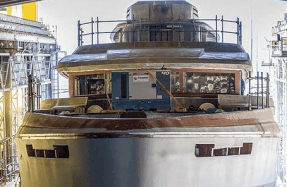HULLS ON AIR


Reducing fuel consumption, bettering performance: the available solutions to do this on a boat are several. Among these, there’s the following which entails placing air between the hull’s surface and water so as to reduce friction. In fact this is one of the better known and intuitive expedients but at the same time in practical terms it is not easy to do. But prior to examining some of the solutions available to do this, let’s begin to understand why by placing air between water and a surface, friction is reduced. Air, in addition to being about 1000 times less dense than water is also a fluid which is far less viscous than water, this being a physical feature which allows for an easier flow of an object through the same fluid. This ease of flowing motion is technically referred to as possessing less friction or more precisely less viscous friction, in other words that special type of friction which is typical of fluid flow motion (see box for more data). To better understand the phenomenon imagine an object which is not immersed in water but in honey, a sweet and pleasant fluid no doubt but one that is much denser and viscous than water is: it’s therefore easy enough to understand that it is going to be very difficult to make it flow or slide or skim since the degree of friction engendered by the high viscosity will be enormous. And so returning to the hull in other words that portion of the boat which is in direct contact with the water and were we to somehow insert air between the surface and water, the flow motion of this last along the hull surface will be facilitated and we’ll obtain what’s defined as lubrification brought about by air. After all lubrification has been defined as being non other than the interposing of a lubricating substance which reduces friction between two reciprocally flowing surfaces. When talking about friction it is commonly understood that the reciprocally flowing surfaces are made of two solid bodies. In the case of fluids though rather than solids the phenomenon is a little more complex but we can simplify it by imagining that the more viscous and dense fluid of the two behaves like a solid, while the
You’re reading a preview, subscribe to read more.
Start your free 30 days





